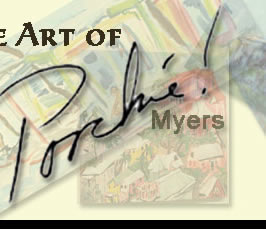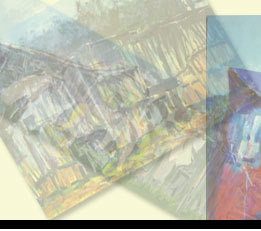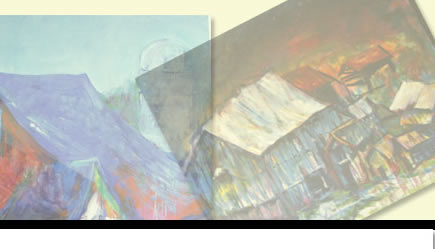Lesson 1
Lesson 2
Lesson 3
Lesson 4
Lesson 5
Lesson 6
Lesson 7
Lesson 8
Lesson 9
Lesson 10
Lesson 11
Lesson 12
Lesson 13
Lesson 14
Lesson 15
Lesson 16
Lesson 17
Lesson 18
Lesson 19
Lesson 20
Lesson 21
|
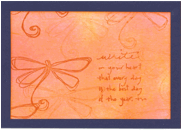 Art Is Easy to Make! Art Is Easy to Make!
lesson 20 By Poochie Myers
Collage As An Art Form
According to the dictionary, collage art is an artistic composition made of various materials (as paper, cloth or wood) glued on a surface." The word comes from the French word "coller," meaning to glue or to paste.
It really is that simple! You use any materials or found objects that you like and glue them down to create a piece of collage art. You can call it by other names: montage, assemblage, or decoupage. But it all comes down to the same thing: a layering of images, color, and texture.
Other art forms (such as painting, carving, weaving, or sculpture) require that you start from ground zero. You have an empty canvas, a slab of clay, a silent loom, an unformed block of wood... and you wait for an idea to take hold of you before you begin.
Collage art is unique because you take already existing materials to make your piece of art. You begin by gathering the bits and pieces you want to use and laying them down however you like. You don't need to know how to draw.
You don't even need to consider yourself an artist! All you need is an open mind and the willingness to explore.
You can make a collage using one type of medium only. For example, a painter could paint a collage by incorporating various seemingly unconnected images into the piece. A quilter can make a fabric collage. A SoulCollage® card is an example of a paper collage.
Mixed Media Collage uses various materials (fabric, yarn, paper, metal, wood) as well as paint, chalk, clay...anything you can get your hands on!
Multi-Media Collage Materials
The base
- mat board
- illustration board
- 300 lb. watercolor paper
- canvas board
I find canvas board to be the best if you are using paint or any wet media in your collage art work. It is the sturdiest and least likely to lose its shape when wet. Also, I like the texture that the canvas immediately gives to my work.
Adhesives:
- acrylic medium
- gel medium
- double-sided tape
- double-sided foam
- spray adhesives (use with caution because of the fumes!
- tacky glue
- E-6000
You will need to experiment with the different kinds of glue until you find the one that you like the best. Keep in mind that one collage piece might use more than one type of glue.
You can buy these materials (and lots more collage art supplies!) at your local art store/craft warehouse, or order fast and easy online from: 
Found Objects:
It's hard to make a set list of things you can include in your collage art. That's because anything and everything in your life can be incorporated into a collage. The possibilities are limitless because there are no rules when it comes to this fascinating art form.
Here is a partial list of the collage materials I have on the shelves of my art room:
- ribbon
- decorative and handmade paper
- yarn
- paper tags
- stickers
- slide frame holders
- acrylic paint
- seashells
- beads
- sea glass
- charms
- old jewelry
- old photos
- jigsaw puzzle pieces
- buttons
- feathers
- pigment ink pads
- copper foil
- wrapping paper
- Scrabble tiles
- pretty napkins
- old playing cards
- bottle caps
- rubber stamps
- keys
- used cd's
- raffia
- glitter
- marbles
- vellum
- corrugated cardboard
Take a look around your house and see what loose odds and ends you can gather up to put into a basket for your next collage.
Make A Collage
Before you get started with your SoulCollage deck , a good way to warm up and get those creative juices flowing is 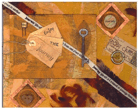 to make a simple mixed-media collage. to make a simple mixed-media collage.
Here are some simple steps:
1. Decide on a base and a glue to start with.
2. Gather a basket of papers and found objects that will add depth, texture, and meaning to your piece. Choose only colors and objects and images that you like!
3. Rip a few pieces of textured paper at random and glue them down onto the base.
4. Add a few more pieces of a different colored paper until the background is covered.
5. Reach into your basket and take out the first thing you touch. It might be a shell, a feather, a piece of fabric, a photo of you when you were 6.
6. Glue it down too!
7. Step back and look at your piece, but not too closely. Does it need some more background? Add it! Does the background look okay? If not, just add some more pieces from your basket, or dab some ink or paint in a few different spots.
8. If you're listening within, your inner artist (creative voice) will tell you when you're finished!
When you're done with this collage art piece, you can go on to create as many more as you like! It's really not hard. Collage art is fun!
Collage is also a common misspelling of the word college.
Collage (From the French: coller, to stick) is regarded as a work of visual arts made from an assemblage of different forms, thus creating a new whole. This technique made its first appearance in the early 20th century as a groundbreaking novelty, but with the passing of time it has become ubiquitous.
For example, an artistic collage work may include newspaper clippings, ribbons, bits of colored or hand-made papers, photographs, etc., glued to a solid support or canvas.
Its adoption has crossed the boundaries of visual arts. In music, with the advances on recording technology, avant-garde artists started experimenting with cutting and pasting since the middle of the 20th century. However in the 1990s and 2000s it is completely apparent that "musical collages" have already become the norm for popular music, especially on rap, hip hop (rap-pop) and electronic music.


A collage made from photographs.
Collage in painting
Cubist painter, Pablo Picasso, invented the collage technique in 1912 with his Still Life with Chair Caning (Nature-morte à la chaise cannée)[1], in which he pasted a patch of oilcloth with a chair-cane design to the canvas of the piece.
Surrealist artists have made extensive use of collage. Cubomania is a collage made by cutting an image into squares which are then reassembled automatically or at random. Inimage is a name given by René Passerson to what is usually considered a style of surrealist collage (though it perhaps qualifies instead as a decollage) in which parts are cut away from an existing image to reveal another image.
Collages produced using a similar, or perhaps identical, method are called etrécissements by Richard Genovese from a method first explored by Marcel Mariën. Genovese also introduced excavation collage (that includes elements of decollage) which is the layering of printed images, loosely affixed at the corners and then tearing away bits of the upper layer to reveal images from underneath, thereby introducing a new collage of images. Penelope Rosemont invented some methods of surrealist collage, the prehensilhouette and the landscapade.
Collage was often called the art form of the 20th century, but this was never fully realised.
Surrealist games such as parallel collage use collective techniques of collage making.
Collage made from photographs, or parts of photographs, is called photomontage.
Another technique is that of canvas collage, which is the application, typically with glue, of separately painted canvas patches to the surface of a painting's main canvas. Well known for use of this technique is British artist John Walker in his paintings of the late 1970s, but canvas collage was already an integral part of the mixed media works of American artist Jane Frank by the early 1960s. The intensely self-critical Lee Krasner also frequently destroyed her own paintings by cutting them into pieces, only to create new works of art by reassambling the pieces into collages.
Decoupage
Decoupage is a type of collage usually defined as a craft. It is the process of placing a picture onto an object for decoration. Often decoupage causes the picture to appear to have depth and look as though it had been painted on the object.
The process is to glue (or otherwise affix) a picture to an object, then adding more copies of the picture on top, progressively cutting out more and more of the background, giving the illusion of depth in the picture. The picture is often coated with varnish or some other sealant for protection.
Wood collage


What can be called wood collage is the dominant feature in this 1964 mixed media painting by Jane Frank (1918-1986).
Wood collages are a relative novelty in the world of collages. It was during a 15-year period of intense experimentation beginning in the mid 1940s that Louise Nevelson evolved her sculptural wood collages, assembled from found scraps, including parts of furniture, pieces of wooden crates or barrels, and architectural remnants like stair railings or moldings. Generally rectangular, very large, and painted black, they resemble gigantic paintings. Concerning Nevelson's Sky Cathedral (1958), the Museum of Modern Art catalogue states, "As a rectangular plane to be viewed from the front, Sky Cathedral has the pictorial quality of a painting..." [2]. Yet such pieces also present themselves as massive walls or monoliths, which can sometimes be viewed from either side, or even looked through.
Much wood collage art is considerably smaller in scale, framed and hung like a painting. It usually features pieces of wood, wood shavings and scraps, assembled on an empty canvas (if there is painting involved), or on a wooden board. Such framed, picture-like, wood-relief collages offer the artist an opportunity to explore the qualities of depth, natural color, and textural variety inherent in the material, while drawing on and taking advantage of the language, conventions, and historical resonances that arise from the tradition of creating pictures to hang on walls. The technique of wood collage is also sometimes combined with painting and other media in a single work of art.
Frequently, what is called "wood collage art" uses only natural wood - such as driftwood, or parts of unworked logs, branches, sticks or bark. This raises the question of whether such artwork is collage (in the original sense) at all. This is because the early, paper collages were always constructed from human-made bits of text or pictures - things made by people and originally "signifying" in some cultural context. The collage brings these still-recognizable "signifiers" (or fragments of signifiers) together, in a kind of semiotic collision. A truncated wooden chair or staircase newel used in a Nevelson work can also be considered a potential element of collage in the same sense: it had some original, culturally determined context. Unworked, natural wood, such as one might find on a forest floor, arguably has no such context. (Driftwood is of course sometimes ambiguous: while a piece of driftwood may once have been a piece of worked wood - for example, part of a ship - it may be so weathered by salt and sea that its past functional identity is nearly or completely obscured.)
Digital collage
Digital collage is the technique of using computer tools in collage creation to encourage chance associations of disparate visual elements and the subsequent transformation of the visual results through the use of electronic media.
|

